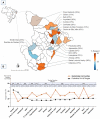A higher number of SARS-COV-2 infections in quilombola communities than in the local population in Brazil
- PMID: 37304100
- PMCID: PMC10253171
- DOI: 10.3389/fpubh.2023.1095162
A higher number of SARS-COV-2 infections in quilombola communities than in the local population in Brazil
Abstract
The historical and social vulnerability of quilombola communities in Brazil can make them especially fragile in the face of COVID-19, considering that several individuals have precarious health systems and inadequate access to water. This work aimed to characterize the frequency of SARS-COV-2 infections and the presence of IgM and IgG SARS-CoV-2 antibodies in quilombola populations and their relationship with the presence of risk factors or preexisting chronic diseases in the quilombola communities. We analyzed the sociodemographic and clinical characteristics, serological status, comorbidities, and symptoms of 1,994 individuals (478 males and 1,536 females) from 18 Brazilian municipalities in the State of Sergipe of quilombola communities, which were evaluated at different epidemiological weeks, starting at the 32nd (August 6th) and ending at the 40th (October 3rd) epidemiological week. More than 70% of studied families live in rural areas and they have an extreme poverty social status. Although we found a higher number of SARS-COV-2 infections in quilombola communities than in the local population, their SARS-CoV-2 reactivity and IgM and IgG positivity varied across the communities investigated. Arterial hypertension was the most risk factor, being found in 27.8% of the individuals (9.5% in stage 1, 10.8% in stage 2, and 7.5% in stage 3). The most common COVID-19 symptoms and comorbidities were headache, runny nose, flu, and dyslipidemia. However, most individuals were asymptomatic (79.9%). Our data indicate that mass testing must be incorporated into public policy to improve the health care system available to quilombola populations during a future pandemic or epidemic.
Keywords: COVID-19; anti-SARS-CoV-2 antibodies; quilombola; quilombola communities; risk factors.
Copyright © 2023 Martins, de Souza, de Rezende Neto, Santos, da Invenção, Matos, dos Santos, de Jesus, da Silva, de Almeida, do Vale, Fonseca, Schimke, Matos, Oliveira, Ferreira, de Paula Dias, dos Santos, Barbosa, de Carvalho Barreto, Moreno, Gonçalves, de Mello Silva, Cabral-Marques and Borges.
Conflict of interest statement
The authors declare that the research was conducted in the absence of any commercial or financial relationships that could be construed as a potential conflict of interest.
Figures




References
-
- Monitora COVID-19 . Available at: https://bigdata-covid19.icict.fiocruz.br/ (Accessed March 16, 2023)
-
- Observatório COVID-19 BR . Available at: https://covid19br.github.io/ (Accessed March 16, 2023)
Publication types
MeSH terms
Substances
LinkOut - more resources
Full Text Sources
Medical
Miscellaneous

